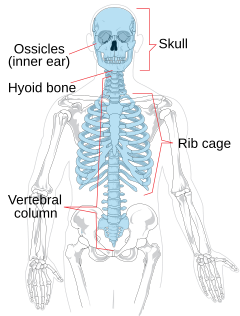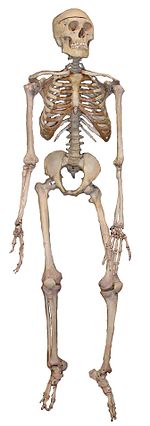




As you sit and type at the keyboard, while you swing on a swing, even when you pick up your lunch, you're using the bones in your fingers, hand, wrist, and arm.
Each arm is attached to a shoulder blade or scapula (say: sca-pyuh-luh), a large triangular bone on the upper back corner of each side of the rib cage. The arm is made up of three bones: the humerus (say: hyoo-muh-rus), which is above your elbow, and the radius (say: ray-dee-us) and ulna (say: ul-nuh), which are below the elbow.

Each of these bones is wider at the ends and skinnier in the middle, to help give it strength where it meets another bone. At the end of the radius and ulna are eight smaller bones that make up your wrist. Although these bones are small, they can really move! Twist your wrist around or wave and you'll see how the wrist can move.
The center part of your hand is made up of five separate bones. Each finger on your hand has three bones, except for your thumb, which has two. So between your wrists, hands, and all your fingers, you've got a grand total of 54 bones — all ready to help you grasp things, write your name, pick up the phone, or throw a softball!
Your heart, lungs, and liver are all very important, and luckily you've got ribs to keep them safe. Ribs act like a cage of bones around your chest. It's easy to feel the bottom of this cage by running your fingers along the sides and front of your body, a few inches below your heart. If you breathe in deeply, you can easily feel your ribs right in the front of your body, too. Some thin kids can even see a few of their ribs right through their skin.
Your ribs come in pairs, and the left and right sides of each pair are exactly the same. Most people have 12 pairs of ribs, but some people are born with one or more extra ribs, and some people might have one pair less.

All 12 pairs of ribs attach in the back to the spine, where they are held in place by the thoracic vertebrae. The first seven pairs of ribs attach in the front to the sternum (say: stur-num), a strong bone in the center of your chest that holds those ribs in place. The remaining sets of ribs don't attach to the sternum directly. The next three pairs are held on with cartilage to the ribs above them.
The very last two sets of ribs are called floating ribs because they aren't connected to the sternum or the ribs above them. But don't worry, these ribs can't ever float away. Like the rest of the ribs, they are securely attached to the spine in the back.
Your spine is one part of the skeleton that's easy to check out: Reach around to the center of your back and you'll feel its bumps under your fingers.
The spine lets you twist and bend, and it holds your body upright. It also protects the spinal cord, a large bundle of nerves that sends information from your brain to the rest of your body. The spine is special because it isn't made of one or even two bones: It's made of 26 bones in all! These bones are called vertebrae (say: ver-tuh-bray) and each one is shaped like a ring.
There are different types of vertebrae in the spine and each does a different kind of job:
The first seven vertebrae at the top are called the cervical (say: sir-vih-kul) vertebrae. These bones are in the back of your neck, just below your brain, and they support your head and neck. Your head is pretty heavy, so it's lucky to have help from the cervical vertebrae!
Below the cervical vertebrae are the thoracic (say: thuh-ras-ick) vertebrae, and there are 12 in all. These guys anchor your ribs in place. Below the thoracic vertebrae are five lumbar (say: lum-bar) vertebrae. Beneath the lumbar vertebrae is the sacrum (say: say-krum), which is made up of five vertebrae that are fused together to form one single bone.
Finally, all the way at the bottom of the spine is the coccyx (say: cok-siks), which is one bone made of four fused vertebrae. The bottom sections of the spine are important when it comes to bearing weight and giving you a good center of gravity. So when you pick up a heavy backpack, the lumbar vertebrae, sacrum, and coccyx give you the power. When you dance, skip, and even walk, these parts help keep you balanced.

In between each vertebra (the name for just one of the vertebrae) are small disks made of cartilage. These disks keep the vertebrae from rubbing against one another, and they also act as your spine's natural shock absorbers. When you jump in the air, or twist while slamming a dunk, the disks give your vertebrae the cushioning they need.



 consists of both fused and individual bones supported and supplemented by ligaments, tendons, muscles and cartilage. It serves as a scaffold which supports organs, anchors muscles, and protects organs such as the brain, lungs and heart.
consists of both fused and individual bones supported and supplemented by ligaments, tendons, muscles and cartilage. It serves as a scaffold which supports organs, anchors muscles, and protects organs such as the brain, lungs and heart. The longest and heaviest bone in the body is the femur and the smallest is the stapes bone in the middle ear. In an adult, the skeleton comprises around 20% of the total body weight, and half of this weight is water.
Fused bones include those of the pelvis and the cranium. Not all bones are interconnected directly: There are six bones in the middle ear called the ossicles (three on each side) that articulate only with each other. The hyoid bone, which is located in the neck and serves as the point of attachment for the tongue, does not articulate with any other bones in the body, being supported by muscles and ligaments.